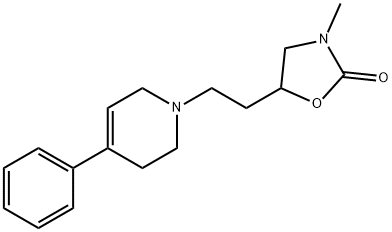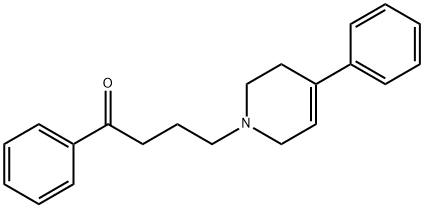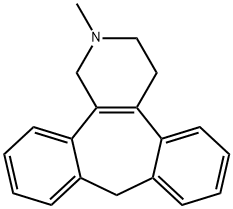1-METHYL-4-PHENYL-1,2,3,6-TETRAHYDROPYRIDINE
- CAS NO.:28289-54-5
- Empirical Formula: C12H15N
- Molecular Weight: 173.25
- MDL number: MFCD00006120
- EINECS: 248-939-7
- SAFETY DATA SHEET (SDS)
- Update Date: 2023-05-15 10:44:00

What is 1-METHYL-4-PHENYL-1,2,3,6-TETRAHYDROPYRIDINE?
Chemical properties
Light Yellow Solid
The Uses of 1-METHYL-4-PHENYL-1,2,3,6-TETRAHYDROPYRIDINE
1-Methyl-4-phenyl-1,2,3,6-tetrahydropyridine is a dopaminergic neurotoxin that reportedly causes a severe and irreversible Parkinsonian condition in humans and monkeys.
What are the applications of Application
1-Methyl-4-phenyl-1,2,3,6-tetrahydropyridine, free base is a dopaminergic neurotoxin
Definition
ChEBI: A tetrahydropyridine that is 1,2,3,6-tetrahydropyridine substituted by a methyl group at position 1 and a phenyl group at position 4.
Metabolic pathway
N-Methyl-4-phenyl-1,2,3,6-tetrahydropyridine (MPTP) in a rat pheochromocytoma cell line is oxidized to give the N-methyl-4-phenylpyridinium ion.
Properties of 1-METHYL-4-PHENYL-1,2,3,6-TETRAHYDROPYRIDINE
| Melting point: | aprox. 36°C |
| Boiling point: | 128-132 °C12 mm Hg(lit.) |
| Density | 1.001±0.06 g/cm3(Predicted) |
| storage temp. | Inert atmosphere,Room Temperature |
| solubility | Chloroform (Slightly), Dichloromethane (Slightly), Ethyl Acetate (Slightly) |
| pka | 8.66±0.40(Predicted) |
| form | Solid |
| color | Pale Yellow to Light Yellow |
| Merck | 13,6319 |
| Stability: | Stable. Incompatible with strong oxidizing agents. |
Safety information for 1-METHYL-4-PHENYL-1,2,3,6-TETRAHYDROPYRIDINE
Computed Descriptors for 1-METHYL-4-PHENYL-1,2,3,6-TETRAHYDROPYRIDINE
New Products
Tert-butyl bis(2-chloroethyl)carbamate (S)-3-Aminobutanenitrile hydrochloride N-Boc-D-alaninol N-BOC-D/L-ALANINOL N-octanoyl benzotriazole 4-Hydrazinobenzoic acid 3,4-Dibenzyloxybenzaldehyde 1,1’-CARBONYLDIIMIDAZOLE R-2-BENZYLOXY PROPIONIC ACID 1,1’-CARBONYLDI (1,2-4 TRIAZOLE) 4-HYDROXY BENZYL ALCOHOL 3-NITRO-2-METHYL ANILINE (2-Hydroxyphenyl)acetonitrile 4-Bromopyrazole 5-BROMO-2CYANO PYRIDINE 5,6-Dimethoxyindanone 5-broMo-2-chloro-N-cyclopentylpyriMidin-4-aMine 4-methoxy-3,5-dinitropyridine 2-(Cyanocyclohexyl)acetic acid 2-aminopropyl benzoate hydrochloride 1-(4-(aminomethyl)benzyl)urea hydrochloride tert-butyl 4- (ureidomethyl)benzylcarbamate diethyl 2-(2-((tertbutoxycarbonyl)amino) ethyl)malonate Ethyl-2-chloro((4-methoxyphenyl)hydrazono)acetateRelated products of tetrahydrofuran




![METHYL-4-PHENYL 1,2,3,6-TETRAHYDROPYRIDINE, 1-, [METHYL-14C]](https://img.chemicalbook.in/StructureFile/ChemBookStructure2/GIF/CB0130619.gif)


![METHYL-4-PHENYL 1,2,3,6-TETRAHYDROPYRIDINE, 1-, [METHYL-3H]](https://img.chemicalbook.in/StructureFile/ChemBookStructure2/GIF/CB1120901.gif)
You may like
-
 873-83-6 6-Aminouracil (or) 4-Amino-2,6- dihydroxypyrimidine, (or) 6-Amino2,4-pyrimidinediol 99%View Details
873-83-6 6-Aminouracil (or) 4-Amino-2,6- dihydroxypyrimidine, (or) 6-Amino2,4-pyrimidinediol 99%View Details
873-83-6 -
 55441-95-7 99%View Details
55441-95-7 99%View Details
55441-95-7 -
 N-Vinylformamide 99%View Details
N-Vinylformamide 99%View Details
13162-05-5 -
 Chloro Uracil 1820-81-1 99%View Details
Chloro Uracil 1820-81-1 99%View Details
1820-81-1 -
 207557-35-5 99%View Details
207557-35-5 99%View Details
207557-35-5 -
 2-ethyl-6-methyl-3-hydroxypyridine succinate 99%View Details
2-ethyl-6-methyl-3-hydroxypyridine succinate 99%View Details
127464-43-1 -
 2-ETHYLPYRIDINE 100-71-0 99%View Details
2-ETHYLPYRIDINE 100-71-0 99%View Details
100-71-0 -
 181228-33-1 (S)-Methyl 3-amino-2-((tert-butoxycarbonyl)amino)propanote Hydrochloride (DAP-OMe. HCl) 99%View Details
181228-33-1 (S)-Methyl 3-amino-2-((tert-butoxycarbonyl)amino)propanote Hydrochloride (DAP-OMe. HCl) 99%View Details
181228-33-1
Statement: All products displayed on this website are only used for non medical purposes such as industrial applications or scientific research, and cannot be used for clinical diagnosis or treatment of humans or animals. They are not medicinal or edible.